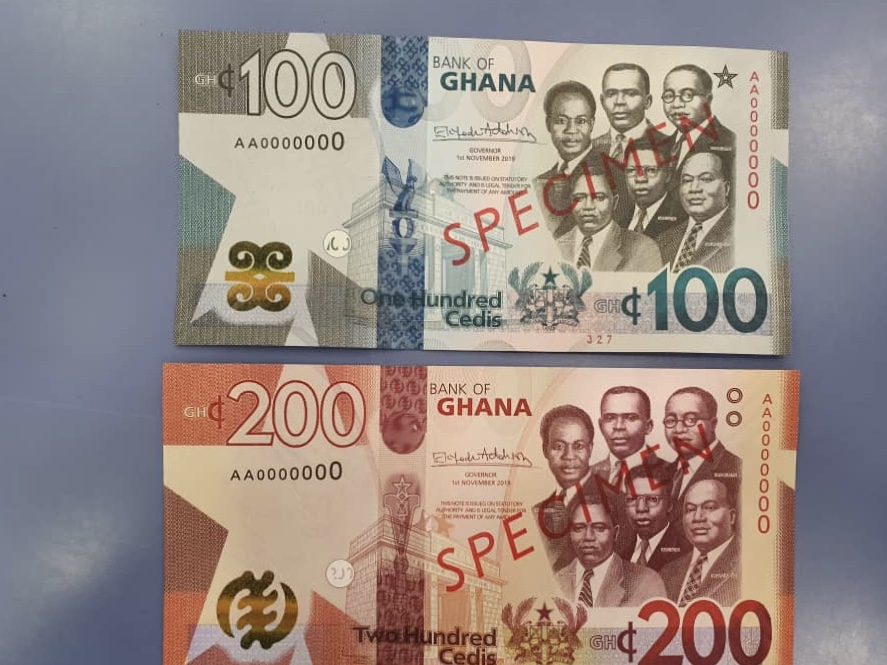
BoG introduces new denominations
The Bank of Ghana (BoG) has introduced two new higher denominations of the Ghana notes and a coin to complement the existing currencies in circulation.
The new denominations are the hundred and two hundred Ghana cedi notes and a two cedis coin that are expected to be in circulation from Monday, December 2, 2019.
Advertisement
Features
The size of the new GH¢100 is 157mm x 80mm and is predominantly grey in colour with turquoise highlights. The main image at the back of the GH¢100 banknote is Ghana’s Parliament Chamber with the secondary image of the Parliament building.
The GH¢ 200 is predominantly terracotta with red grey highlights with the seat of Government, the Jubilee House, as the main image at the back.
The GH¢2 coin has the image of the Ghana Coat of Arms on the front with the Jubilee House at the back, both embossed on silver with gold around it like a fence.
Convenience and efficiency
Speaking at the launch of the currencies, Governor of the Bank of Ghana, Dr Ernest Addison, said the introduction of the new denominations was to complement the existing series to ensure customer convenience and bring about efficiency in the printing of currency to generate savings for the country.
Dr Addison said high levels on inflation and currency depreciation in the past had eroded some of the gains of the redenomination in 2007.
Deadweight burden
Dr Addision said the deadweight burden reflected in high transaction cost had re-emerged. This set of high denominations will address the increased transaction cost in a high valued transactions in a cash-based economy.
“These new higher value denominations will only restore partially the dollar value of the higher denomination of GH¢200 to about US$40”.
“This may not be quite close to levels in 2007, but high enough to significantly reduce the deadweight burden and high transaction cost in making high-valued purchases in a cash-based economy like Ghana,” Dr Addison said.
“This is why we continue to pay attention to enhancements in the structure, security features and management of cash within the economy. This will stay with us for some time”, he added.
Currency reforms
As part of the currency reforms, the central bank in May this year upgraded some of the currency to enhance the security features of the banknotes in the context of an evolving technological landscape.
Analysts have urged the central bank to be cautious on the circulation of the higher denominated banknotes.
The Governor said it was normal practice in all jurisdictions for central banks to periodically review the structure of their currencies with the view to ensuring that they were aligned with macroeconomic conditions and demand.
He cautioned that the introduction of the high value is not a shift away from the country’s policy of pursuing a cashless society and promoting the use of electronic modes of payments.
“While vigorously pursuing financial inclusion by accelerating the migration to e-payment platforms, we are also mindful of the relevance of cash in our day-to-day dealings. Undeniably, cash still remains the preferred medium of payment by the large informal sector in the country”, he said.
High depreciation
In 2007, when the country redenominated its currency, GH¢50 was equivalent to $50 but 12 years on, the same GH¢50 is now worth only $9.
It has depreciated by more than 80 per cent.
In a bid to restore some of the lost parity to the dollar, the central bank has introduced the highest banknote of GH¢200, which is four times the previous highest denomination. But not even a fourfold increase in the highest denomination could restore the parity it had in 2007.
Not solution to depreciation
A Senior Economist at Databank, Mr Courage Martey, agrees that the structure of the banknote should align with the needs of the people who use it for their daily transactions, but cautioned that the higher denominations should be limited in supply and in circulation as the introduction of higher denominations will not tackle the fundamental problems of the persistent high inflation and the perennial currency depreciation.
“As long as these fundamental issues are not addressed, we could be coming back to introduce yet another set of higher denominations in the next decade”, he said.
Mr Martey suggested to the country’s economic managers to keep an eye on low inflation and a stable Ghana Cedi.
“If we don't achieve these fundamental correction in the economic indicators, the real value of these new higher denominations will be eroded and we will have to come back to introduce even higher notes”, he said.





